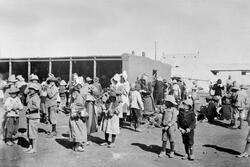On Emancipation Avenue
My friend wanted to get arrested, one morning in July, on the curb of the sidewalk along a street east of downtown Houston. Emancipation Avenue. That’s where she intended to stand while, she anticipated, her hands would be shackled, her arms hoisted up, her body thrust into the backseat of a cop car. On the street named for liberation, she would sing Hebrew as they hauled her away, freedom ringing in her voice and radiating from her eyes.
She informed me of the protest the day before, while on her way back from another demonstration in Oklahoma. Her firebrand of a five-foot tall, curly-haired Jewish mother hiked the two of them up to the site of Fort Sill, a 19th and 20th century internment camp where the US government forcibly converted Native tribes and imprisoned Japanese Americans during World War II. As the presidential administration prepared to detain 1,400 Latin American migrant children at Fort Sill, hundreds of activists (from a plethora of communities) crowded beneath a highway outside the building, employing the collective weight of their bodies and the force of their voices to implore the government not to make use of this camp once more. Jews, remembering our own difficult migrations and our history with concentration camps, traveled far to attend.
The sight on Emancipation Avenue the following morning appeared much the same. Packed together, Jews lined the sidewalk of a barred detention center that holds migrant teenagers. One long-isolated people weeping for another.
A rabbi addressed our cohort of furious, dismayed Jews, brandishing a tattered Haggadah that escaped Nazi Germany with his grandfather. Holding up the Haggadah, he turned to the camp behind us and issued a purposeful statement: “Not in my name, and not in my time.” I lifted a poster with the words of Elie Wiesel as I screamed my assent.
When a reporter from The Houston Chronicle asked me why I chose to protest on Emancipation Avenue that day, I repeated the words of the rabbi. I explained that, by bringing the story of my Jewish ancestors into the present to defend the rights of others, I was participating in the age-old Jewish tradition of creating our identity, our name, through action.
My friend—a Latina Jewish teenager who painted fiercely doleful blue stars on her legs—didn’t end up encountering the police that morning. But three weeks later, while back sitting on Emancipation Avenue, she watched her mother earn the awaited handcuffs and make the sacred pilgrimage to the police station.
Pilgrims are people who venture to a sacred place, and their journey is equal parts travel and destination. As Jews, our pilgrimages take us from one land, one mindset, one tradition, one generation to the next because we recognize that, in order to survive, we must grow our peoplehood by challenging ourselves to leave behind the comfort of the now (where we are, what we know, how we act) and move, learning space, time, life anew. Time flows, and we take pilgrimages to keep moving alongside it, adapting and expanding our Jewish identity.
I’ve watched for years as Jewish pilgrims in our time journey to chart the course of our people; I’ve studied the formative journeys of past millennia. But I failed to comprehend that this movement crafted the history, the identity, the people I hold dear, until my friend’s mother was arrested under the proud gaze of her daughter. No matter how hard we may try to remain quiet and still, we cannot situate ourselves, unnoticed, in one space, one mindset, for long. When there are political, social, religious developments in society and the world changes, we move.
And why do we move? Sometimes it’s in response to persecution (or most of the time: even when we move or make a choice unmotivated by antisemitism, we’re probably—if unwittingly—influenced by our age-old affliction to some degree.) Sometimes it’s to intervene in immoral politics, such as our aforementioned immigration protests. Sometimes the movement happens in response to internal change, in pursuit of new meaning for tradition. Sometimes, it’s to create space. To care for others. To pursue justice. To foster inclusion. To learn for ourselves. To teach our children.
I am a Jew because I embrace such movement. I look to the Jewish pilgrims for guidance in each new life exploration. My understanding of the Jewish people teaches me to resist passivity and immobility. Be it a curse or a blessing, stagnation, in my eyes, is our communal antithesis. Change serves as one of our few constants. Ideological nomads who make our home in the history of our travels.
Every Jewish service or holiday acts as a reminder to shift our mindset. We interpret our religious texts, doctrines, and stories to spark new quests; these teachings are but maps to our next Temple. The Shalosh Regalim, the three Jewish holidays with Biblical pilgrimages to the Temple, never died.
And like all things Jewish, this pilgrimage manifests in limitless ways. Jews might quite literally pack up and move, expanding our Diaspora.
Or we might re-envision or revitalize a tradition within our homes. We might align ourselves with a cause and join an organization marching towards social justice. We might put pen to paper and embolden our community through a speech, a poem, a memoir, or a post. Or we might trek to Emancipation Avenue, one late morning in July, wielding tattered Haggadahs and signs with quotes: tributes to the Jewish pilgrims of our past. We might bear bold blue stars, strategically etched on our legs, our arms, our foreheads. And we might lie down in the middle of the street, singing, until the handcuffs arrive.
This article was republished on Teen Voices.
This piece was written as part of JWA’s Rising Voices Fellowship.








Interesting perspective! I really like this.